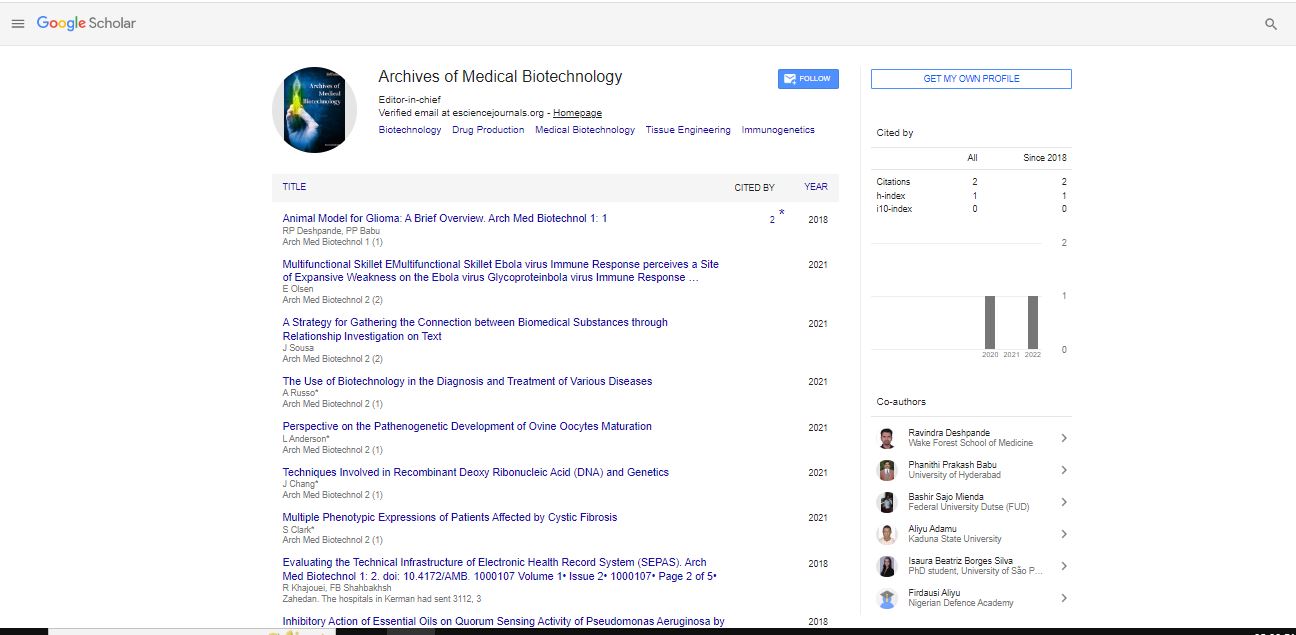Perspective, Arch Med Biotechnol Vol: 4 Issue: 2
Biosensors: Innovations in Disease Detection and Monitoring
Micael Lechano*
Department of Biology, Nebraska Wesleyan University, 5000 Saint Paul Avenue, Lincoln, NE 68504, USA
*Corresponding Author: Micael Lechano,
Department of Biology, Nebraska
Wesleyan University, 5000 Saint Paul Avenue, Lincoln, NE 68504, USA;
E-mail: Micaellechano@ac.edu
Received date: 22 May, 2023, Manuscript No. AMB-23-106365;
Editor assigned date: 24 May, 2023, PreQC No. AMB-23-106365 (PQ);
Reviewed date: 16 June, 2023, QC No. AMB-23-106365;
Revised date: 26 June, 2023, Manuscript No. AMB-23-106365 (R);
Published date: 03 July, 2023 DOI: 10.4172/amb.1000046.
Citation: Lechano M (2023) Biosensors: Innovations in Disease Detection and Monitoring. Arch Med Biotechnol 4:2.
Abstract
Biosensors have emerged as powerful tools in medical biotechnology, enabling rapid and sensitive detection of biomarkers for disease diagnosis and monitoring. This manuscript provides a comprehensive overview of biosensors and their applications in disease detection and monitoring. It explores different types of biosensors, including optical, electrochemical, and nanosensors, highlighting their working principles and advantages. The manuscript discusses the use of biosensors in diagnosing diseases, monitoring treatment responses, and enabling point-of-care testing. It also addresses the challenges and future prospects of biosensor technologies in improving healthcare outcomes.
Keywords: Biosensors; Electrochemical; Diagnosing diseases
Description
The biosensors and their role in disease detection and monitoring. It emphasizes the need for rapid and sensitive diagnostic tools and highlights the unique capabilities of biosensors in addressing these challenges.
Working principles of biosensors
This section discusses the working principles of biosensors. It explores the recognition element, such as antibodies, enzymes, or nucleic acids, which selectively bind to target biomarkers. It explains the transduction element, which converts the binding event into a measurable signal, such as optical, electrochemical, or nanoscale signals.
Optical biosensors
This section focuses on optical biosensors, which utilize light-based signals for biomarker detection. It discusses techniques such as Surface Plasmon Resonance (SPR), fluorescence, and luminescence, which enable real-time and label-free detection, by exploring the advantages of optical biosensors, such as high sensitivity and multiplexing capabilities, and their applications in disease diagnosis and monitoring.
Electrochemical biosensors
This section delves into electrochemical biosensors, which employ electrical signals for biomarker detection. It discusses techniques such as amperometry, potentiometry, and impedance spectroscopy, which offer high sensitivity and rapid response. By exploring the applications of electrochemical biosensors in detecting various biomarkers in diseases such as diabetes, cancer, and infectious diseases, where people can understand clearly.
Nanosensors
This section explores the emerging field of nanosensors, which utilize nanoscale materials and structures for biomarker detection. It discusses the use of nanoparticles, nanowires, and nanotubes in enhancing sensitivity and selectivity, highlighting the potential applications of nanosensors in early disease detection and personalized medicine.
Disease diagnosis and monitoring
This section discusses the applications of biosensors in disease diagnosis and monitoring. It explores how biosensors can detect specific biomarkers associated with diseases, enabling early detection and accurate diagnosis, highlighting the use of biosensors in monitoring treatment responses and disease progression, providing real-time and personalized information for healthcare management.
Point-of-care testing
This section focuses on the role of biosensors in point-of-care testing, where rapid and on-site diagnostic tools are essential. It discusses the portability and user-friendly nature of biosensors, enabling their use in resource-limited settings, by exploring the examples of biosensors used in point-of-care testing for infectious diseases, cardiac markers, and glucose monitoring.
Challenges and considerations
This section addresses the challenges and considerations associated with biosensor technologies. It discusses the need for assay standardization, sensor reliability, and cost-effectiveness, highlighting the importance of regulatory considerations, data privacy, and ethical implications in the development and implementation of biosensors.
Future perspectives
The conclusion highlights the transformative potential of biosensors in disease detection and monitoring. It discusses the future prospects of biosensor technologies, such as the integration of artificial intelligence and wearable biosensors, by emphasizing the need for continued research, technological advancements, and interdisciplinary collaborations to further enhance the capabilities of biosensors and improve healthcare outcomes.
Conclusion
In summary, biosensors offer innovative solutions for disease detection and monitoring. The manuscript explores different types of biosensors, including optical, electrochemical, and nanosensors, and their applications in disease diagnosis and monitoring. It discusses the challenges and considerations associated with biosensor technologies and highlights the future prospects of this field in improving healthcare outcomes. With ongoing advancements and research, biosensors have the potential to revolutionize disease diagnostics, enable personalized medicine, and enhance patient care.
 Spanish
Spanish  Chinese
Chinese  Russian
Russian  German
German  French
French  Japanese
Japanese  Portuguese
Portuguese  Hindi
Hindi 